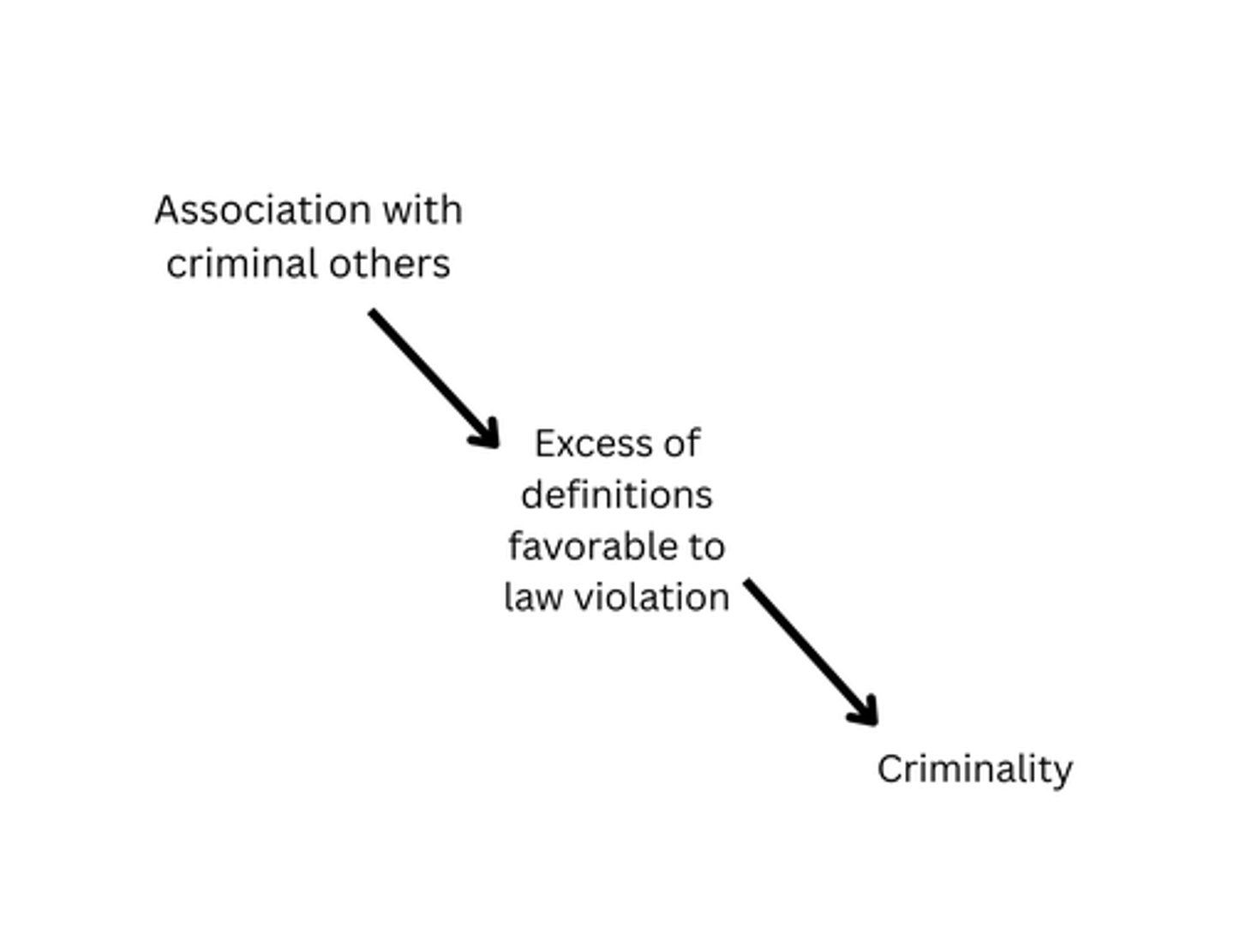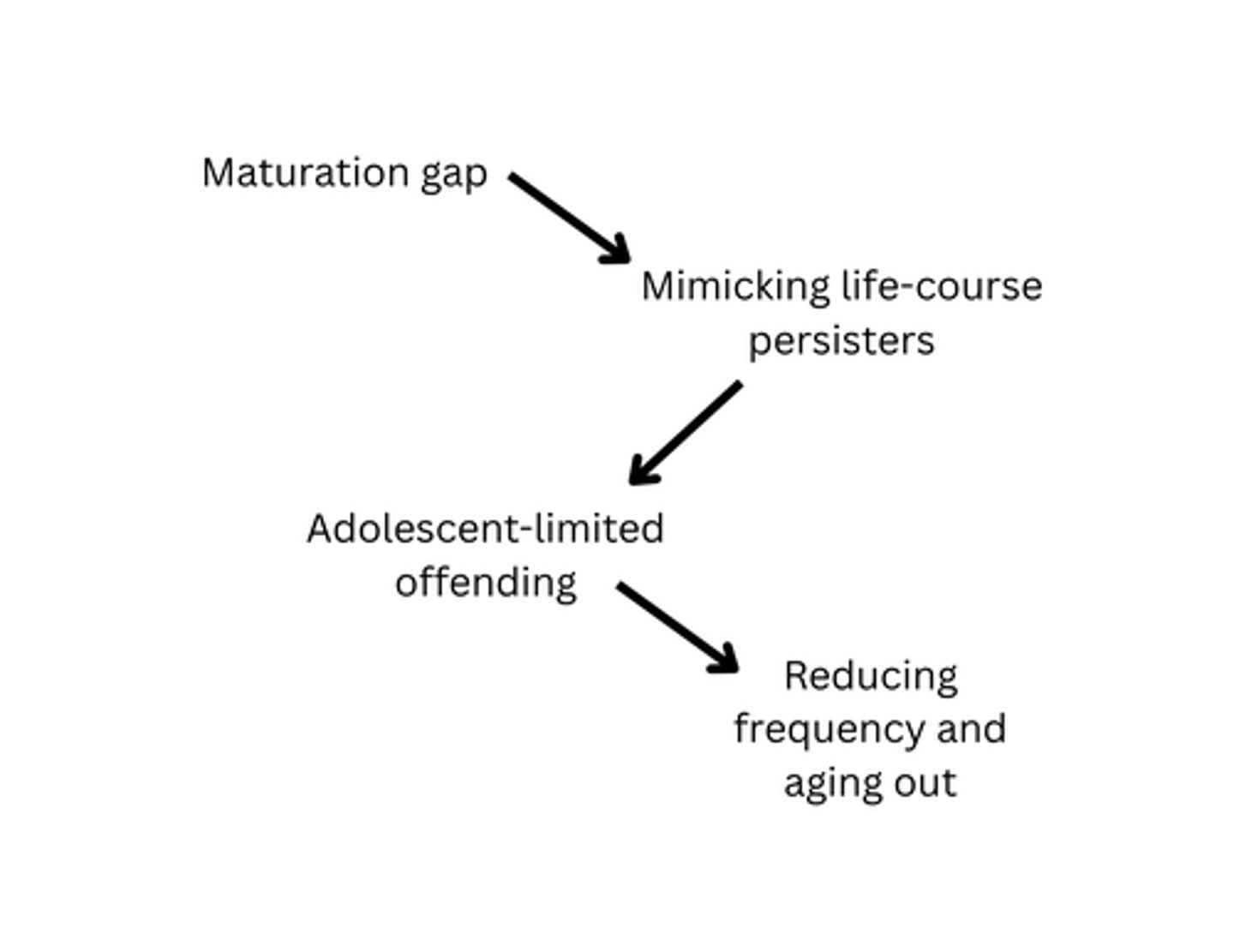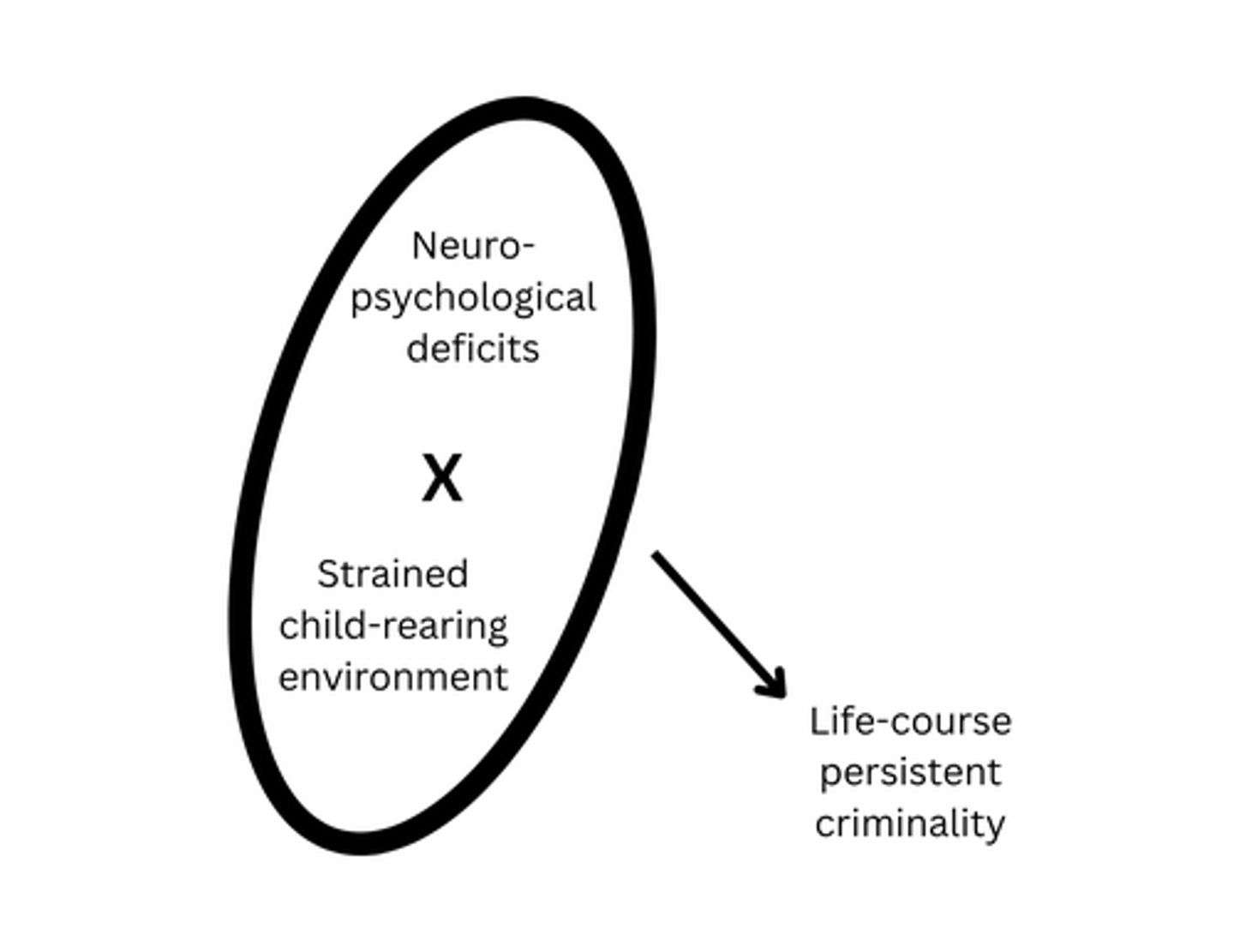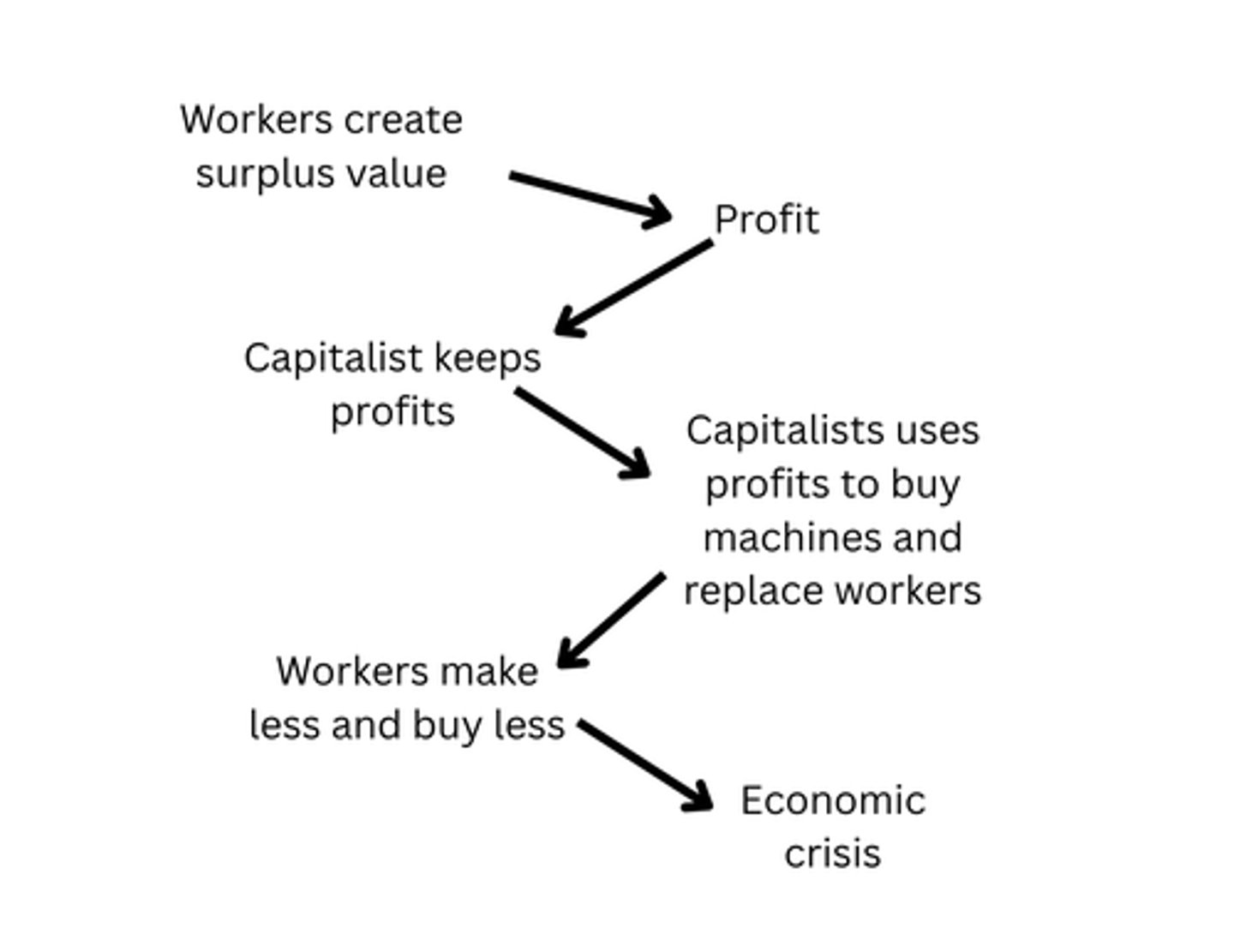Criminology Exam 3
1/69
There's no tags or description
Looks like no tags are added yet.
Name | Mastery | Learn | Test | Matching | Spaced |
|---|
No study sessions yet.
70 Terms
Socialization
The interactions people have with various organizations, institutions, and processes of society
Learning theories (social process)
Assert that criminality is a function of socialization, that relationships produce criminality, and that all people, regardless of race, class, or gender, have teh potential to offend; explains why some people with no economic or social reason commit crime; explains why most residents of "disorganized" areas do not commit crime
Social learning theory
The theory that people learn the techniques and attitudes of crime from close relationships with criminal peers; crime is a learned behavior
Three social learning theories
Sutherland and Cressey's Differential Association Theory, Burgass and Akers' Differential Reinforcement Theory, and Sykes and Matza's Neutralization Theory
Sutherland and Cressey's Differential Association Theory
Learning/social process theory that asserts that crime is learned via interaction with intimate groups through an active process, not mere imitation nor transmitted by media and that this learning includes techniques, motives, and rationaizations for crime

Big idea of Sutherland and Cressey's Differential Association Theory
A person becomes delinquent because of an excess of definitions favorable to violations of law over definitions unfavorable to violations of law; everyone is exposed to favorable and unfavorable definitions, it is the excess that matters
Four factors that cause variance in differential associations according to Sutherland and Cressey's Differential Association Theory
Frequency (times exposed to message), duration (length of time exposed to others sending the message), priority (earlier in life is more influential), intensity (credibility/value of communicator)
Burgass and Akers' Differential Reinforcement Theory
Learning/social process theory that asserts that criminal behavior that is positively reinforced will lead to persistent criminality; accounts for people exposed to criminal others but who do not commit crimes

Sykes and Matza's Neutralization Theory
Learning/social process theory that asserts that offenders still have a sense of morality beyond laws and that they are not immune to the demands of conformity
Traits of offenders that support Sykes and Matza's Neutralization Theory that offenders still have a sense of morality beyond laws
Sometimes voicing a sense of guilt over their illegal acts, frequently respecting and admiring honest, law-abiding people, drawing a line between those whom they can and cannot victimize, and drifting back and forth between illegitimate and conventional behavior
Techniques used to neutralize moral blame/conventional values (mastered by repeat offenders)
Denial of victim ("he had it coming"), denial of injury ("they have insurance/enough money"), denial of responsibility ("they made me do it"), condemnation of condemner ("everyone steals"), appeal to higher loyalties ("I have to protect my friend")
Subculture theories
Theories that assert that offenders learn skills, norms, values, and attitudes conducive to lawbreaking from the subgroup in which they live, which is separated from the dominant culture.
Cohen's Status Frustration Theory/Theory of Delinquent Boys
Subculture theory that asserts that youths from working-class families desire middle-class status (respect), and after realizing they cannot achieve these goals due to the poverty trap, they develop a subculture in opposition to middle-class values that results in further separation from middle-class culture

Miller's Lower-Class Focal Concerns
Subculture theory that asserts that criminality is due to the individual's attempt to adhere to forms of behavior and to achieve standards of value within that community; the lower-class develops its own subculture to maintain its way of life (not in opposition to middle-class) with six focal concerns (value systems)
Miller's six focal concerns (value systems) developed by the lower-class
Trouble (unwelcome involvement with officials of middle-class society (ex. attention from law enforcement)), toughness (physical prowess, masculinity, bravery), smartness (ability to outfox/con others and avoid being conned with minimal physical effort), excitement (thrill-seeking), fate, autonomy
Anderson's Theory of the Code of the Streets
Subculture theory that asserts that a subculture of violence exists due to adherence to a specific code that everyone has to know and follow; code exists due to neighborhood disadvantage (goal blockage) due to institutionalized racism
Elements within Anderson's code of the streets
Respect (most important), projecting a tough image, informal rules regarding how to respond if challenged ("dissed")
Two types of families within Anderson's Code of the Streets
Decent and street
"Decent" families within Anderson's Code of the Streets
People group within a subculture who have not internalized the code of the streets, accept mainstream values (ex. hard work), hope for a better future for their kids, are often involved in church, and whose children adopt the code for self-protection but do not internalize it
"Street" families within Anderson's Code of the Streets
People group within a subculture who have internalized the code of the streets and in it as a way of life, are marked by disorganization, try to approximate the "decent" family model but tend towards self-destructive behavior, harshly discipline children (thereby teaching them to use violence to solve disputes), and have given up hope of leaving the disadvantaged community, teaching their kids how to survive in that harsh environment (king of the hill) instead of encouraging them to get out
Code-switching/social shuffle (Anderson's Code of the Streets)
Acting like the group of people you are around when it isn't how you would normally act
Social control theories
Question is not "why do people commit crimes?" but "why do people NOT commit crimes?"; includes Hirshi's Social Bond Theory and Gottfredson & Hirshi's General Theory of Crime
Social control
Deference from crime out of not wanting to lose bonds
Hirshi's Social Bond Theory
Social control theory that asserts that criminality is the result fo weakend ties to society; in the absence of sensitivity to and interest in others, a person is free to commit criminal acts
Elements that affect criminality according to Hirshi's Social Bond Theory
Attachment, commitment, involvement, belief
Attachment (Hirshi's Social Bond Theory)
Sensitivity to others and their opinions, concern that engaging in delinquent behaviors risks losing ties to others
Commitment (Hirshi's Social Bond Theory)
Interest in conformity and conventionality, those who have status, responsibility, and respect for others have too much to lose to engage in delinquent behaviors
Involvement (Hirshi's Social Bond Theory)
If time is taken up by conventional activity, there is no time to engage in deviance
Belief (Hirshi's Social Bond Theory)
Degree to which one thinks they should obey society's rules
Gottfredson and Hirschi's General Theory of Crime
Social control theory that asserts that the inclination to commit crime is tied directly to a person's level of self-control, but also needs the opportunity to commit crime; offenders suffer from low self-control that develops early in life due to inadequate child-rearing; crime rates change because of changes in opportunity and perceived value of crime; early offending as adolescents predicts offending; people with low self-control age out of crime because of increases in inducements to refrain from crime
Questions left unanswered by theories prior to life-course/integrated theories
Why do many offenders commie one crime and never offend again?
Why do some people escalate the severity of crimes, while others de-escalate and age out?
What causes some criminal offenders to stop offending and then restart?
Link between the age of onset and continued crime
The earlier a child engages in deviance and criminality, the more likely they will have a longer and more serious criminal career; suggests that the factors that produce long-term offending emerge early in life
Traditional adult life-course
Grow up, leave home, marry, start a family
Life course theory
Theory that asserts that crime is not stable or constant, disruptions in life transitions promote criminality, positive experiences may help some criminals desist (defer from criminal conduct), while negative experiences may cause criminal activity to resume
Nature of (elements that contribute to) changes in social interactions within life course theory
Family, peer relations (level of influence), vocational achievement, marital relationships
Sampson and Laub's "Age-Graded Theory" (Persistent Offending and Desistance from Crime)
Life course theory that asserts that individual traits and childhood experiences are important, but do not alone explain the continuity of crime into adulthood; human choice remains the equation; positive and negative life experiences can redirect criminal trajectories; positive experiences and relationships can help a person reattach to society
Trajectories (Sampson and Laub's "Age-Graded Theory")
Long-term patterns in life
Transitions (Sampson and Laub's "Age-Graded Theory")
Short-term events embedded into trajectories
Turning points (Sampson and Laub's "Age-Graded Theory")
Life events that alter the development of a criminal career
Role of marriage within Sampson and Laub's "Age-Graded Theory"
Transforms people by cutting off a person's past and providing new relationships, reduces the opportunity to commit crimes, and reduces exposure to deviant peers as they adopt a set schedule
Cumulative disadvantage (Sampson and Laub's "Age-Graded Theory")
Repeated negative experiences in adolescence that undermine life chances and reduce employability and social relations, and make them more likely to engage in crime; lacking social supports to help them reject deviant solutions to personal problems; ex. limited access to healthcare, school dropout, loss of job
Social capital (Sampson and Laub's "Age-Graded Theory")
Positive relations with individuals and institutions that are life-sustaining; interacts with social bonds and social control
Moffitt's Adolescent-Limiteds and Life-Course Persisters ("Pathways to Crime")
Moffitt's adolescent-limiteds
People who commit crimes as adolescents and then stop, considered "typical teenagers" who get into minor rebellious behavior, includes most people, driven by a maturation gap (wanting to act older) but stop engaging in behavior when they learn better, may mimic anti-social behavior of more troubled teens (persisters) when they reach mid-teens, reduce the frequency of offending and age out

Moffitt's Life-Course Persisters
People who begin offending at a very early age and continue to offend into adulthood; may combine the effects of abnormal traits with severe family dysfunction; more likely to have low verbal ability, impaired reasoning skills, and limited learning ability
Childhood/adolescence of Moffitt's Life-Course Persisters
Have significant issues in their reasoning ability when they are young compared to limiteds; may have neuropsychological traits (genetics, brain injury, poor prenatal care) that make them more difficult to raise (prone to temper tantrums and violent outbursts), leads to a series of failed parent-child interactions due to limited resources to help a struggling child; child engages in deviance and fails to gain life skills that may help them overcome deficits later in life

Social reaction (labeling) theory
Theory that people shape behavior based on interaction and interpretation; involves the power of negative labels and significance of labelers
Dramatization of evil (social reaction (labeling) theory)
Negative feedback of important others that amplifies the force of the original label and causes stigmatized offenders to begin to reevaluate their own identities; the person becomes the thing they are deserved as being
Retrospective reading (social reaction (labeling) theory)
The past of the labeled person is reviewed and reevaluated to fit their current status
Primary deviance (social reaction (labeling) theory)
Crimes that have very little influence on the actor and can be quickly forgotten; sees causes of crime as external to ourselves
Secondary deviance (social reaction (labeling) theory)
Acceptance of a deviant label as personal identity; acts as a basis for self-concept; evolves over time; in a back-and-forth sequence with significant others (degree of hostility/resentment over stigmatization)
Conflict/critical theories
Theories that shift the focus away from the offender and toward the role of social institutions and political (group relationship) dynamics
Conflict theory
Critical theory that asserts that antisocial behavior stems from class conflict and socioeconomic inequality; crime is a function of social conflict and economic rivalry; conflict promotes crime by creating a social atmosphere where law is used to control the "have-nots" and maintain the power of the wealthy
Real crimes (conflict theory)
Crimes that are bigger than just street crimes; ex. racism, sexism, genocide, unsafe working conditions, pollution
Marxist thought (conflict theory)
Identifies the economic structures in society that control all human relations (capitalist bourgeoisie, proletariat, lumpen proletariat); asserts that capitalist society demoralizes workers and creates crime; the capitalist system produces the haves and have-nots, competitiveness destabilizes social institutions and social groups
Capitalist bourgeoisie (Marxism)
Owners of the means of production
Proletariat (Marxism)
People who do the actual labor
Lumpen proletariat (Marxism)
Non-productive, parasitic members of society
Thoughts on the justice system according to Marxism (within conflict theory)
Justice system protects the rich and powerful, the law is not an absolute moral code, the poor are controlled through incarceration, the middle class is scared by the poor "criminals", the law is lenient towards white-collar workers
Causes of crime (Marxism within Conflict Theory)
Surplus value and marginalization

Surplus value (Marxism within Conflict Theory)
Efforts to increase profits produced by laboring classes that are accrued by business owners; goods exceed wages in value
Marginalization (Marxism within Conflict theory)
As more people are thrust outside the economic mainstream, a larger portion of the population is forced to live in areas conducive to crime
Instrumental theory
Conflict theory that asserts that the law and justice system serves the rich and powerful (system used as an instrument); the poor may or may not commit more crimes, but they are arrested more often; can be demystified by showing how capitalist law preserves ruling class power
Structural Theory
Conflict theory that asserts that the law is designed to keep the system operating efficiently (not necessarily to serve the rich and powerful)
Critical theory
Theory that describes and critiques the social structure and seeks solutions to the problems of crime and criminal justice
Feminist criminology (within critical theory)
Asserts that gender inequality is at the root of offenses in which women are the victims or offenders
Evil woman hypothesis (feminist criminology)
Idea that women who do not meet gender norms are punished especially harshly within the justice system (ex. mother who hurts her child)
Peacemaking criminology (within critical theory)
Asserts that the efforts of the state to punish are crime-encouraging; shaming criminals into thinking that not only were their action(s) bad, but they are also bad as a person; culture of severed relationships causes crime, should focus on mutual aid instead of punishment; should use restorative justice to try to fix issues at the root
Critical race theory
Asserts that racial inequity is so ingrained in society that it is propagated through legal and social discourse; hearing people's stories and what they go through is very valuable
Cultural criminology (within critical theory)
Examines how social ideas, values, and media reflect and produce antisocial behavior (ex. media depictions of crime (war on drugs, war propaganda)